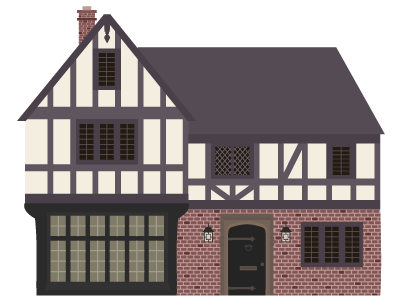Buying a Grade 2 Listed House
- Buying a Grade II listed building means you'll be owning a property of special architectural or historical interest.
- A grade II listed building is not exempt from Stamp Duty Land Tax (SDLT). The property's features, historical significance, and renovation work come into account when calculating how much you'll owe.
- Make sure you can verify any previous renovation work done on the property was carried out with the right permissions and listed building consent. Otherwise, you will be liable to fix any mistakes.
- A Grade 2 listed property will always require a Level 3 Home Survey before buying.
- If your Grade 2 listed property contains historically significant furniture, this may be protected by English Heritage, in addition to the listed building protections managed by the local authority.
Are you keen to own a piece of history? Buying a Grade 2 listed house offers a unique opportunity to live in a property steeped in character and charm. However, such a special property will come with challenges and responsibilities.
What is a listed building?
A listed building is a property deemed to be of special architectural or historic interest. In England, there are over 370,000 listed buildings (Source: Historic England) and they are classified into three grades (the lower the grade, the more restrictions in place):
- Grade I: Exceptional interest (approximately 2.5% of listed buildings). Iconic examples include Westminster Abbey and St Paul's Cathedral.
- Grade II*: Particularly important buildings (approximately 5.5% of listed buildings). This includes properties like the Royal Crescent in Bath.
- Grade II: Special architectural or historic interest (approximately 92% of listed buildings). This is the most common grade, covering a wide range of properties.
Listing was introduced in the 1947 Town and Country Planning Act to legally protect culturally significant buildings. It prevents demolition without consent and restricts alterations that might harm the building's character. It's important to note that a listed property includes any structures attached like extensions or outbuildings, and also includes gardens and statues.
Just because a building looks old, doesn't necessarily mean it's listed. There are plenty of modern properties which mimic historic features for aesthetics.
Ready to instruct on your purchase?
Get a free, no-obligation quote to handle the purchase of a listed building. Our panel of solicitors are experienced with listed property sales and purchases.
Pros and cons of owning a grade 2 listed house
Pros
- Character and charm: Distinctive architectural features and historical significance combine to create a visually striking living space.
- Potential value appreciation: Listed homes often increase in value over time due to their rarity and historical importance.
- Community connection: Owning a listed property can connect you to the local heritage and community.
- Investment potential: A grade II listed building can be an attractive investment due to its potential for capital growth and rental income.
- Lifestyle benefits: Living in a historic property can offer a unique and fulfilling lifestyle.
Cons
- Costly maintenance and repairs: Older properties often require special care and can be expensive to maintain. You might need to hire specialist tradespeople who only deal with unique materials and are trained to look after the property carefully. For example, a stonemason who needs to source materials from a local quarry and then perform the work might set you back an additional 30%-50% on top of standard work costs.
- Renovation restrictions: Planning permission is often needed for alterations, and building materials may be restricted, increasing costs and complexity.
- Insurance complexities: Finding suitable insurance coverage can be difficult due to the risks associated with listed buildings, often leading to higher premiums.
- Energy efficiency challenges: Older properties can be less energy efficient, leading to higher energy bills.
- Potential impact on lifestyle: Some listed buildings may have smaller rooms, lower ceilings, or inefficient layouts compared to modern homes.
In our recent survey, 16% of homeowners found defects; including 2% who were able to pull out of a bad purchase, 7% who were able to negotiate a better price, and sadly, 7% of homeowners who did not get a survey and discovered defects after the purchase.
12 of the 39 who remembered how much these defects cost to remedy spent over £5,000
Don't burn your money, book a survey.

What can't you do to a Grade 2 listed building?
You can typically replace like-for-like for maintenance and repairs in listed properties, but you are still likely to require permission to do so. Any changes or removals will absolutely need prior permission before work starts.
External alterations
Changes to the building's exterior, such as windows, doors, roofing, and external decorations, usually require approval. This involves the materials, style, and placement of any additions.
Internal alterations
While minor repairs and internal changes are allowed, significant structural modifications or removing original features may require approval, such as altering walls, removing fireplaces, or changing room layouts.
Specific restrictions
Certain materials and methods may be prohibited, such as PVC windows or cement rendering; traditional materials and techniques are often preferred.
Double glazing
Installing double glazing often requires obtaining listed building consent due to its potential visual impact. Careful consideration of the type of glazing is essential to preserve the building's character.
Removal of architectural features
Features like fireplaces, panelling, or decorative stonework are often protected and cannot be removed without prior consent.
Stone cleaning
Harsh cleaning methods can damage stonework. Approved cleaning techniques must be used to preserve the original appearance.



Additions to the property
Adding extensions, conservatories, or outbuildings typically requires planning permission from local authorities and may be subject to additional restrictions.
Boundary changes
Removing or altering boundary walls or gates will require consent, especially if they contribute to the building's character.
Chimney alterations
Removing chimney stacks or pots is generally not allowed due to their architectural value.
Repointing
Using incorrect materials, such as cement mortar, can damage the building and is often prohibited. Lime mortar is typically required for historic buildings.
Stamp duty on listed buildings
Listed buildings are not exempt from Stamp Duty Land Tax (SDLT). However, there's no straightforward formula for calculating the amount due. Whilst the general SDLT rules apply based on the property's value and the buyer's status, there are indirect implications for stamp duty on listed homes.
The property's special features, historical value, and the extent of renovations can impact the calculation. If extensive restoration is required to bring the property up to standard, it will likely increase its overall value and that means a higher SDLT bill. It's best to seek professional advice when purchasing a listed property to accurately determine your stamp duty liability.
There are ways to lighten the financial load, though. For example, if the property was empty for two years before you bought it, or if it needs serious renovation work, then you might qualify for relief. You could even get a discount on the cost of repairs, as sometimes that's used to reduce the sum of stamp duty payable.
Top tips for purchasing a grade 2 listed property
Thorough research is essential when purchasing a Grade 2 listed property. Use the National Heritage List for England to gain insights into the property's history, architectural significance, and any existing restrictions. This invaluable resource provides detailed information about the property's protected status and its role within the local heritage. However, you should be aware that if you purchase a listed property, your home will be searchable.
Grants are also available from Historic England for certain circumstances, such as for local authorities and organisations looking to protect the nation's heritage with renovation work.
You should aim to speak with your local conservation officer to help you submit plans and for consultation. They will likely hold a lot of valuable knowledge on the property itself, as well as the rules and regulations for the specific area.
Choosing the right home insurance policy
Due to the risks associated with listed buildings, securing the right insurance coverage is crucial.
The rebuilding cost for a listed property is often significantly higher than for a standard property due to the use of traditional materials and specialist craftsmanship. Some insurers may be reluctant to cover listed buildings, so it's important to shop around and find a specialist provider.
The importance of a comprehensive survey
A detailed survey is indispensable when purchasing a listed property. Instructing a surveyor with experience in grade II listed properties and buildings is crucial as they understand the specific challenges and potential issues associated with these properties.
The survey should comprehensively assess the building's structure, damp, electrical systems, and roofing. In some cases, additional specialist surveys, such as damp and timber surveys, may be recommended.
Check for previous renovation work - listed building consent
You should verify that any previous renovations or alterations to the property were carried out with the right permissions.
Get documentation from the seller to confirm that work complies with listed building regulations. Be aware that as the new owner, you'll be responsible for rectifying any unauthorised work.
If you buy a listed property and find out the previous owner carried out work without listed building consent, the local authority might issue an enforcement notice. This means you will be required to undo the unauthorised work.
While the previous owner is responsible for the original offence, you could be held criminally liable if you don't comply with the enforcement notice.
This also means that the property's value could be affected and it might end up difficult to sell in the future.
Purchasing a listed building?
We can help. Our friendly and professional panel of solicitors will ensure a swift buying process for you.
Our conveyancing quotes are all-inclusive, which means they include all the standard work for your transaction, including standard disbursements on your transaction.
Jack is our resident Content Writer with a wealth of experience in Marketing, Content, and Film. If you need anything written or proof-read at a rapid speed and high quality, he's your guy.
Caragh is an excellent writer and copy editor of books, news articles and editorials. She has written extensively for SAM for a variety of conveyancing, survey, property law and mortgage-related articles.









